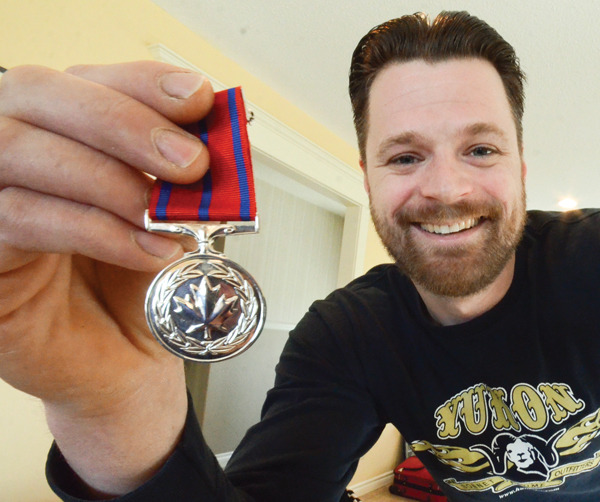Winners

2013
John Cerne
Modest hero braves rig fire to save coworker
By Correy Baldwin
It was a bitterly cold day, on March 23, 2012. John Cerne, a 29-year-old diamond driller, and two other men were working on a rig at Foraco’s Avalon Rare Minerals, Nechalacho deposit next to Thor Lake, Northwest Territories. The men were cementing a drill hole shut when without warning an explosion rocked the rig.
“I sort of went down,” says Cerne. “I was looking at the hole, and when I looked up I was on fire, pretty much from head to toe.” A fireball had engulfed his side of the rig. The team had been using an external pump that they would later find out had not been installed properly. As they worked, the pump began to heat up. When it reached super-hot temperatures the strain became too much, and it blew.
“I managed to find the door,” says Cerne, “and flung myself out into the snow bank.” Outside it was minus 40 Celsius, and Cerne, covered in burning hydraulic oil, rolled in the snow to smother the flames.
“That’s when I looked back and noticed that my partner was on the floor in the back of the rig in a burning pool of oil,” he says. Cerne immediately plunged back into the rig to rescue his partner.
“It’s very hard to explain because it happened so quick,” he says. “You don’t think about the decisions you make in those milliseconds. It’s just something that needs to be done. All I knew was he was going to burn to death if we didn’t get him out of there.” Cerne carried the man out of the flames, setting him down outside the rig. “I was bear-hugging him, trying to smother the flames between the two of us,” he recalls.
They had escaped, but they weren’t out of danger yet – the burning rig was surrounded by diesel barrels, propane tanks and other highly flammable materials. “They always say if the rig ever catches on fire you let it burn,” says Cerne. “But when I looked at him I could see he was badly burned. I didn’t know if I could move him.” So he dove into the flames one more time, grabbing two fire extinguishers and got the fire under control.
Cerne and the third worker, who had escaped unscathed, got the man onto a sled and took him to a second rig, a half-kilometer away. There they wrapped his badly burned hands and arms in a jacket for protection.
Cerne then left to get help. He jumped onto a skidoo to rush to the camp – another kilometer away – even though his own hands were too badly burned for him to put on gloves.
Cerne suffered second-degree burns to both his hands, and burns to the back of his neck – injuries he most likely sustained during his return trips into the fire. He also lost some facial hair, he says. “I grow a big beard every winter for the cold, so I had a huge beard at the time, and it melted it right to my face.”
When Cerne returned to work in early July, to his surprise, he was assigned to the same rig. “It was very strange, just to walk in there,” he says. “It was all cleaned up and repainted, but it was the exact same rig.”
Although his co-worker was badly burned, Cerne says it could have been much worse. “He’s looking really good. Another couple of minutes in there and he probably wouldn’t look the way he looks today. The heat was just starting to get to his face. He’s very lucky.”
Cerne, however, is quiet about his heroism, and reluctant to accept credit: “It’s something you just do because it’s another human, right?” he concludes.
2007
Joseph Louis Sikora
156th Person awarded the CIM Medal for bravery for "great bravery displayed in the McGillivray Creek Mine"
 - dev.png)

